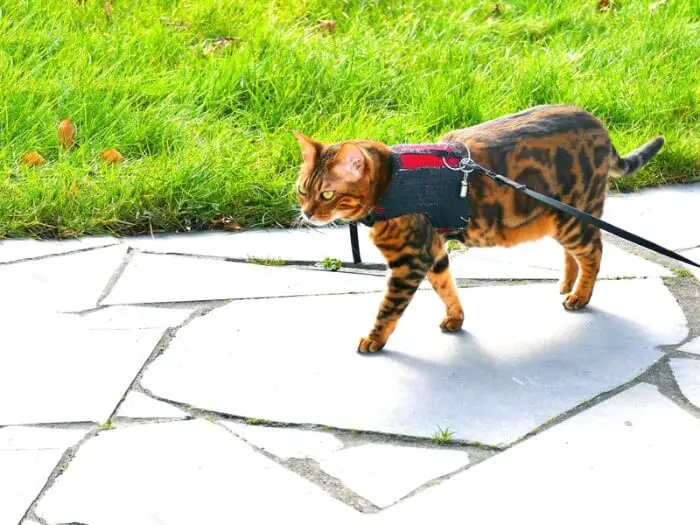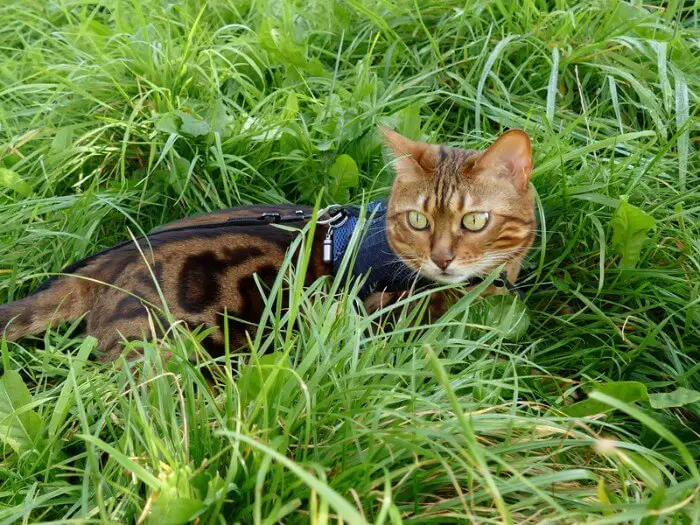No, a cat cannot wear a harness all the time.
The harness should only be used when your cat needs to be restrained or you are going for a walk.
Leaving a harness on a cat is not only uncomfortable for your cat but is also dangerous.
The harness can become a safety issue when your cat is left unattended and your cat is likely to feel negative towards wearing the harness if it is left on for too long.
Reasons Why Your Cat Shouldn’t Permanently Wear A Harness
A cat harness is an excellent tool for cat owners to use but it should not be used all the time.
A harness should only be utilized for walks or when your cat needs to be restrained (for example, a vet visit or car trip).
There are multiple reasons why keeping a harness on your cat permanently is a bad idea:
It Is Unsafe
First of all, the reason a harness is used in the first place is that it helps to keep your cat nearby and safe during outings.
If the harness is left on all the time then your cat will be spending time unsupervised in the harness and this is extremely unsafe.

The harness can get caught on items such as on furniture causing your cat to be stuck.
This will not only result in a negative experience for your cat (causing them to dislike the harness) it can also be extremely dangerous and even life-threatening.
It Is Uncomfortable
Even if your cat is comfortable in the harness when you go for walks, wearing it all the time will be uncomfortable.
The harness may begin to cause skin irritation and hair loss due to rubbing.
The harness is not designed to be worn for long periods and your cat won’t enjoy wearing it for long periods either.
Your Cat May Try To Break Free
The longer you leave your cat in the harness, the more frustrated they will become.
Your cat may try to chew through the harness to get it off or they may try to escape in different ways.
This could cause them to ingest the harness material as they chew through it or they could get stuck while they are trying to escape.
It Can Disrupt Natural Behaviours
The harness is ideal for walking around on a leash but if your cat wants to lie down, sit, or even run around the harness can get in the way and interfere with these behaviours.
It Can Get In The Way Of Grooming
When wearing a harness, your cat won’t be able to fully groom itself.
This can cause problems with matted fur and hygiene if the harness is left on for long periods of time.
The harness can also rub against their skin causing irritation and discomfort.
Are Cat Harness Cruel?
No, a cat harness is a fantastic tool for keeping your cat secure when on walks or going out of the house, for example when traveling or going to the vet.
A harness is much safer than collars for walking your cat as a collar puts pressure on the throat which is more likely to cause damage and choking.

Cats are generally unsure of the harness at first so basic training is needed to get them comfortable wearing it for short periods of time.
Lots of treats and positive reinforcement is needed so your cat associates wearing the harness with positive experiences.
Once your cat is happy wearing the harness it can actually be beneficial for their mental health and their physical health as the harness allows them to go to new places and enjoy new experiences (such as going for walks outside with you).
How Long Can A Cat Wear A Harness For?
A harness can be left on for a couple of hours at a time but should only be worn when you are taking your cat out walking or when you are travelling etc.
The harness should not be left on overnight or for long periods of time as they will start to cause discomfort and rubbing.

When your cat is new to wearing a harness, keeping it on for shorter periods of time is recommended.
You can build up the amount of time the harness is worn as your cat becomes comfortable and tolerant of the harness.
Benefits Of Frequent Harness Use
Frequent harness use is fantastic for training and for spending time outside with your cat.
The key benefits include:
1. Strengthen The Bond With Your Cat
Putting your cat in a harness and taking them outside can help strengthen your bond as you will spend more quality time together.

Some cats love their walks so much they will start purring when the harness comes out as they know they are about to go on an adventure!
2. Harnesses Are Safer Than Collars
A harness is safer than a collar as it secures around your cat’s chest and back allowing the pressure to be distributed.
This stops your cat’s throat and neck from being damaged when walking on a leash as it can be by a collar.
3. Secure
A harness can be adjusted so it fits your cat snugly.
Although not completely escape-proof, they are difficult to get out of.
This makes it easier to keep your cat secure and properly restrained when they are in a harness.
4. Great for Outdoor Adventures
Using a harness is a great way to take your cat outside and let them explore and build up confidence without the risk of them going out of sight or running away.

Taking the time to carry out harness training and frequently using the harness can truly broaden your cat’s horizons.
5. Health Benefits
The harness allows you to take your cat for walks which is great for your cat’s mental and physical health.
Indoor cats are more likely to be overweight and can become bored so a walk outside every now and then is hugely beneficial.
6. Makes Restraint Easier When Needed
A harness helps you keep your cat restrained when at the vets and in other situations where you may need to keep your cat close.
Regularly using the harness will make these types of situations less stressful and easier to manage.
How To Harness Train Your Cat
Introduce the harness to your cat as early as possible, start by placing the harness on the floor so your cat can smell it and become familiar with it.
Place treats around the harness to help ensure the first interactions are positive.
Once your cat has become familiar with the harness and is comfortable being around it you can move on to the next step.

Depending on the comfort level of your cat, you can now either put the harness on your cat or simply drape the harness onto them while giving them treats and positive feedback.
It’s best to keep these interactions short and sweet.
Do this a few times until your cat is comfortable and then allow them to wear the harness for a couple of minutes so they can get used to the feeling of wearing it.
As with the last step, keep the amount of time short at first and allow it to build up with each interaction.
At first, your cat may refuse to move or lay down when you put the harness on them, don’t worry this is quite a common response.
Don’t take the harness off. Instead, just make sure the harness isn’t too tight then give your cat time to get accustomed to it and continue to offer them treats/ playtime with their favourite toy, etc.
Once your cat is used to the feeling of the harness and happy to walk around in it, you can now attach the lead and practice walking around.
Practice this inside at first, walk around the house, and give your cat lots of positive praise, treats, or playtime to reward them.
When your cat is comfortable in the harness when inside, you can take your cat outside. It’s best to keep the first outdoor adventure in a quiet, private area such as a garden.
Your cat is now harness trained and ready for adventures.








Leave a Comment